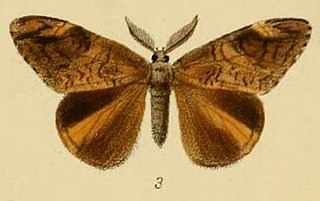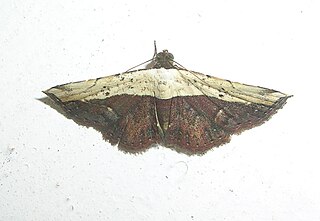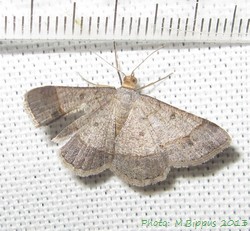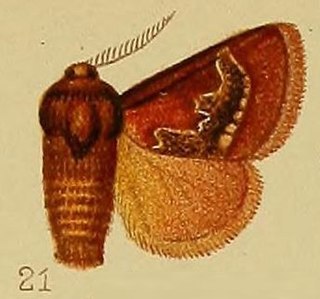
Agrotera is a genus of snout moths in the subfamily Spilomelinae of the family Crambidae. It is the type genus of the tribe Agroterini and currently comprises 28 species distributed in the Afrotropical, Palearctic, Indomalayan and Australasian realm.

Sufetula is a genus of moths of the family Crambidae.

Aroa is a genus of moths in the subfamily Lymantriinae first described by Francis Walker in 1855. Species are distributed in South Africa, China, throughout India, Sri Lanka, Myanmar, and Java.

Ozola is a genus of moths in the family Geometridae first described by Francis Walker in 1861.
Lumaria is a genus of moths belonging to the subfamily Tortricinae of the family Tortricidae.

Lantanophaga pusillidactyla, the lantana plume moth, is a moth of the family Pterophoridae. It is native to the southern United States, Mexico, the Caribbean, and South America. It was introduced to Australia accidentally in 1936 and is now found from Sydney to Cairns along the coast. It has also been introduced to Hawaii in 1902, Pohnpei in 1948, and Palau in 1960 for biological control. It has since been recorded from Yap in 1987–1988 and is now distributed on all islands of the Mariana and Caroline Islands where the host plant is found, except Aguijan.

Oruza divisa is a species of moth of the family Erebidae first described by Francis Walker in 1862. It is found in Asia, including Hong Kong, Sri Lanka, Sulawesi, Taiwan, Japan and in Africa south of the Sahara, including Indian Ocean islands.
Glyphipterix ditiorana is a moth in the family Glyphipterigidae first described by Francis Walker in 1863. It is known from Japan, China, Thailand, India, Sri Lanka, Borneo, Java, Malaysia, Mauritius and South Africa.
Emmalocera nigricostalis is a species of snout moth in the genus Emmalocera. It was described by Francis Walker in 1863. It is found in western Africa, India, Sri Lanka, Myanmar, Borneo, the Andamans, Fiji and Taiwan.
Lamoria adaptella, the plain lamoria, is a species of snout moth in the genus Lamoria. It was described by Francis Walker in 1863 and is known from South Africa, the Gambia, Kenya, Mozambique, India, Sri Lanka, Indonesia and Singapore, as well as Japan and Taiwan.

Loryma recusata is a species of snout moth in the genus Loryma. It was described by Francis Walker in 1863 and is known from Taiwan, Indonesia, Sri Lanka, India, Thailand, western Malaysia and New Guinea. It has also been recorded from northern Australia and South Africa.

Chiasmia normata is a moth in the family Geometridae first described by Francis Walker in 1861. It is found throughout of subtropical Africa and Asia, from India, Japan, Taiwan, Sri Lanka. to the Philippines and in Australia.

Miresa is a genus of moths in the family Limacodidae described by Francis Walker in 1855.
Phricanthes flexilineana is a species of moth of the family Tortricidae first described by Francis Walker in 1863. The species was described from Sri Lanka, northern Queensland in Australia and the Seychelles, but has a much wider range, which includes Madagascar, India, Indonesia, Myanmar, New Guinea, the Philippines and Taiwan. It is also widely distributed in the tropical parts of North and South America.
Nigilgia adjectella is a moth in the family Brachodidae. It was described by Francis Walker in 1863. It is found in Sierra Leone, China, India, Sri Lanka and Australia.
Culladia admigratella is a moth in the family Crambidae. It was described by Francis Walker in 1863. It has a wide range in the tropics, and has been recorded from the British Indian Ocean Territory, Kenya, Malawi, Mauritius, Nigeria, the Seychelles, Sierra Leone, Socotra, India, Myanmar, the Philippines, Sri Lanka and Sumatra.
Surattha invectalis is a moth in the family Crambidae. It was described by Francis Walker in 1863. It is found in Sri Lanka, India, Java, Indonesia, Myanmar, and Kenya.
Lumaria probolias is a species of moth of the family Tortricidae. It is found in India, Sri Lanka, Vietnam and Indonesia, including Java.

Triphassa is a genus of moths of the family Pyralidae described by Jacob Hübner in 1818.
Brachiolia egenella is a species of moth of the family Tortricidae first described by Francis Walker in 1864. It is found in Sri Lanka, India, South Africa and on the Comoros and Mauritius.








